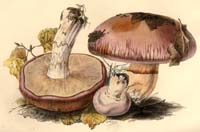 Key to Gilled Mushrooms Key
Key to Gilled Mushrooms KeyThis is a key to gilled mushrooms, that is, mushrooms having a definite cap with a fertile surface consisting of gills. The fruiting body usually also has a stem, although that may be lateral or absent (usually, then, the mushroom is growing from wood). You can use this key to identify mushrooms that you find.
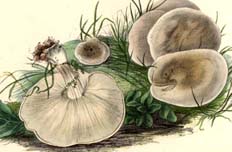 Agaricales Order
Agaricales OrderFruiting body containing fibers (usually in the stalk)
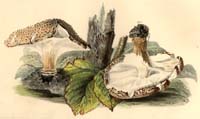 White Spored Suborder
White Spored SuborderSpore print "light-colored": white or buff, sometimes tinged with pink or tan. Greenish and (except for the Russulales) yellow spore prints also go here
Stalk fibrous, not fracturing like a piece of chalk
 Tricholomataceae Family
Tricholomataceae FamilyNone of the special features distinguishing the other white-spored genera:
Gills not free, as in the Lepiotas and Amanitas
Basidia not extra-long, as in the Hygrophoraceae
Spores smooth, except for Lentinellus
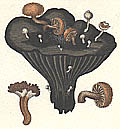 Fungicolous Trich Subfamily
Fungicolous Trich SubfamilyCap less than an inch across
Growing on other fungi, usually on their blackened and squishy remains
Asterophora Genus Ditmar: S. F. Gray
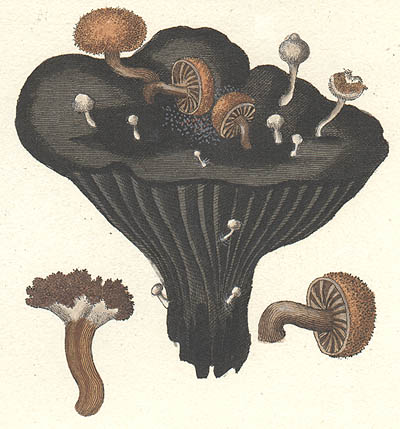
Diagnosis
- Shaped like a normal mushroom, though perhaps with very poorly developed gills and stalk
-
Cap gradually disintegrating into a powdery mass of chlamydospores
Microscropic Characters
Narrow down your identification:
 Asterophora lycoperdoides
Asterophora lycoperdoidesResembling a puffball when young: gills usually contorted, thick
Entire fruiting body originally white or whitish
Cap becoming misshapen and covered with brown powder as its cells grow thick-walled and detach themselves from each other, becoming chlamydospores
Asterophora parasiticaQuite rare
Gills and stem well-developed, entire fruiting body white, silky
It is the gills here that disintegrate into chlamydospores, from the margin on up
Cap remains smooth, although it may darken to brownish-grey in age

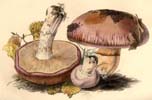


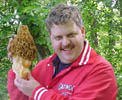

 Key to Gilled Mushrooms Key
Key to Gilled Mushrooms Key Agaricales Order
Agaricales Order White Spored Suborder
White Spored Suborder Tricholomataceae Family
Tricholomataceae Family Fungicolous Trich Subfamily
Fungicolous Trich Subfamily
 Asterophora lycoperdoides
Asterophora lycoperdoides




